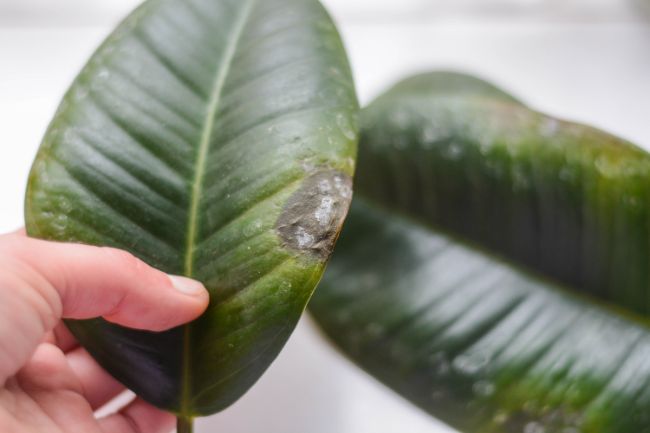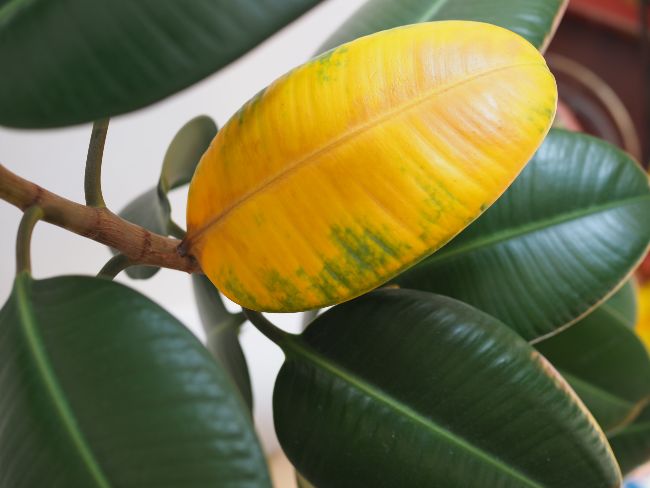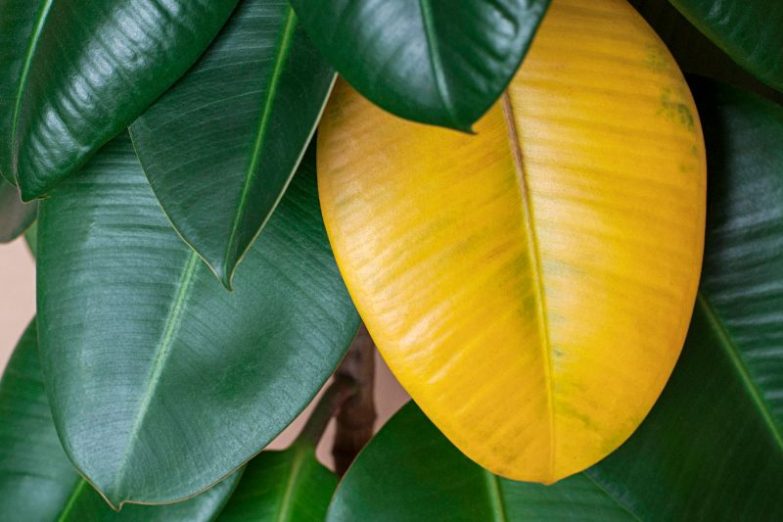Every plant parent dreads the sight of yellow leaves on their plants. If you have a Rubber Plant (Ficus elastica) with leaves that are starting to turn yellow, it could be a sign that something isn’t quite right. In this article, we’ll talk about some of the common causes of rubber plant leaves turning yellow and offer solutions to fix the problem.
Causes of Rubber Plant leaves turning yellow include overwatering, underwatering, sudden changes in lighting or temperature, becoming root bound, pest problems, or simply related to aging foliage. It’s important to identify the cause first and then find a solution.
Let’s familiarize ourselves with the causes of yellow leaves on Rubber Plants one-by-one.
Causes Of Rubber Plant Leaves Turning Yellow
A Rubber Plant (Ficus elastica) with leaves turning yellow is not a very impressive sight. Often, it’s a call of distress from the plant asking you to don your gardener’s hat and fix the problem ASAP, whatever it is. But when you have no idea what exactly you’re doing wrong, it can get pretty frustrating to find solutions.
Thankfully, I am here to help. In order to find out what is wrong with your Rubber Plant, you first have to look for visible signs that the plant is sending your way. Is yellowing affecting all the leaves or just the lower leaves of the plant? Are entire leaves turning yellow or just the tips and edges?
Once you manage to identify the cause correctly, then restoring your rubber plant to its former glory will be like a walk in the park. Listed below are some common causes Rubber Plant leaves turning yellow:
Overwatering
Rubber Plants don’t enjoy sitting in water, but we, as overzealous plant parents, probably don’t realize that until the leaves of the plant start turning yellow.
Do you know that overwatering is one of the most common causes of yellow leaves on Rubber Plants? Also, are you aware that there are multiple causes of overwatering that can cause your Rubber Plant to develop yellow leaves?
Yes, you read that right! There are a number of additional factors that can increase the risk of overwatering, resulting in yellowing of Rubber Plant leaves. These include using pots with insufficient drainage holes or soil with limited aeration.
In case of a pot with clogged or no drainage holes at all, the excess water will not drain out. This, in turn, will result in soggy soil and cause the Rubber Plant’s roots to rot which will eventually lead to the leaves turning yellow and falling off.
And if the soil in which the Rubber Plant is potted has insufficient aeration, it is likely to become waterlogged easily. This will again cause the roots to sit in water for too long, leading to yellowing of leaves.
Easy Ways To Fix Yellow Leaves On Your Rubber Plant Due To Overwatering
If your Rubber Plant has just started showing yellow leaves, chances are you have caught the problem early on. In such a case, it is always advisable to stop watering the plant altogether until the soil dries out and then follow these simple steps:
- Make sure to allow all excess water to drain out after watering so that the roots aren’t left sitting in water.
- Make sure the potting soil is well-aerated. Read my guide to houseplant soil to learn more.
- If you feel that the roots have started to rot, it is best to repot the rubber plant after pruning the affected roots. Follow this guide to rescue your plant.
The best way to determine if your Rubber Plant needs water is to check if the first few inches of the soil are dry. The best way to do this is to poke your finger into the soil to check the level of dryness. Here are some additional tips to work out when to water your houseplants.

Underwatering
Just like overwatering, underwatering can also cause your Rubber Plant to develop yellow leaves. If your Rubber Plant is not getting the moisture that it needs, it is likely to develop droopy leaves that eventually start turning yellow.
So if you spot curling or droopy leaves on your Rubber Plant, it is basically the plant telling you that it is not receiving the water that it needs to sustain its foliage.
Typically, younger leaves tend to droop and turn yellow first in the case of underwatering. Leaves at the top of the rubber plant may start showing yellow tips or edges, and you might also notice stunted growth as the plant is not getting enough water to sustain itself. And of course, the soil will be bone dry as well.
Easy Way To Fix An Underwatered Rubber Plant
The most obvious solution to fix an underwatered Rubber Plant is to water it from time-to-time. Now this ‘time-to-time’ depends on a lot of factors. For example, if it is winter, the plant does not need to be watered as often as in the warm summer months.
Similarly, if your Rubber Plant is in a large pot, it will probably need to be watered less often, as the large volume of soil will take longer to dry out. Other factors like the growth rate of your Rubber Plant, level of humidity, airflow, etc also impact the amount of water that it needs.
Once you have worked out how to tell when your Rubber Plant needs to be watered, all you have to do is remember to check on your plant every few days to make sure it isn’t neglected.
Sudden Change In Lighting
Your Rubber Plant will get used to the lighting conditions where is is positioned in your home, and a sudden change to a more or less bright location can have unintended consequences – you may see your Rubber Plant leaves turning yellow!
This is because your Rubber Plant is trying to acclimatize itself to the change in its environment. A change in position to lower light will cause your Rubber Plant to adapt. Entire leaves may turn yellow and drop as your Rubber Plant decides it can no longer support them.
Conversely, a move to a position where it receives more direct sunlight can cause scorching of the leaves.
Easy Way To Fix This Issue
Rubber Plants do best when kept in a place that receives plenty of bright indirect light. So even if you decide to change its placement, make sure that the new spot that you choose gets enough indirect light for your plant to thrive.
Remember it is always advisable to be consistent when caring for a Rubber Plant, or any houseplant for that matter. They do not appreciate sudden changes in lighting or temperatures.

Overgrown Roots
As your Rubber Plant grows in size, its roots also grow bigger and often get cramped inside the pot due to limited space. This does not just decrease the supply of water and nutrients to the plant, but also interferes with its growth. When the plant does not get the nutrition and water that its needs, it causes its leaves to turn yellow and finally drop off.
Easy Way To Fix This Issue
Rubber Plants tend to grow pretty fast, so in order to let it grow naturally, it is important to check it for signs of becoming rootbound, and repot your Rubber Plant as required.
Needless to say, repot it in a bigger container than the one you are taking it out of. Make sure the new pot has sufficient drainage holes to let the excess water flow out. Be careful while extracting the roots from the previous plant and when repotting, gently prune any dead or diseased roots.
Also, refrain from applying a fertilizer immediately after repotting. It is advisable to wait until you spot signs of new foliage.
Drastic Temperature Change
This is yet another reason for Rubber Plant leaves turning yellow. Unlike us humans who love to sit in front of a fireplace in winters and air cons in summers, Rubber Plants do not react too well to a sudden drastic change in temperature. This is why when you place one near hot or cold drafts, it will become stressed, resulting in yellow leaves, which will often drop off the plant.
Easy Way To Fix The Issue Of Sudden Temperature Change
Ideally, Rubber Plants thrive in temperatures ranging from 50°F (10°C) – 85°F (29°C). Try to place it somewhere that maintains temperatures consistently in the middle of this range. Never place a Rubber Plant too close to any central heating/air conditioning vents as that would greatly impact the humidity levels.
Pests
Yellow leaves on Rubber Plants due to a pest problem should be fairly simple to identify. Most sap sucking pests will damage the leaves where they feed, resulting in small yellow spots on the leaves. The trick is maintaining a watchful eye on your plants to detect the problem early.
Examine your Rubber Plant every few days for any evidence of pests or pest damage, and always keep any new plants quarantined away from your existing houseplants until you are sure no pests have hitchhiked into your home.
I’ve written a separate article about identifying and treating common houseplant pests, which should provide you with all the info you need to get rid of any pest problem.
Aging Plant
It is not always necessary to blame yourself for the yellowing of your Rubber Plant leaves. If you’re doing everything right and can notice no other problem with the plant except for some lower leaves turning yellow, it could just be because your plant is aging. And aging should be a beautiful phenomenon – whether you are human or a rubber plant, right?
So put all that anxiety to rest and just prune the yellow leaves to make your rubber plant look lush and green again. Or you could just do nothing at all and let those yellow leaves drop naturally!
Last Word
If you find your Rubber Plant leaves turning yellow, you should take a little time to examine your plant and determine if there is a problem. Watering problems are the most common issue, so think about these first. Examine the plant, soil and care conditions for any clues about the cause of the problem. Acclimation is common after bringing your plant home from the storeand is generally not a cause for concern.
If you’re struggling to keep your houseplants healthy, you should check out my book, Houseplants Made Easy. This book will teach you everything you need to know to grow thriving houseplants and help you identify problems before they impact the health of your plants.

